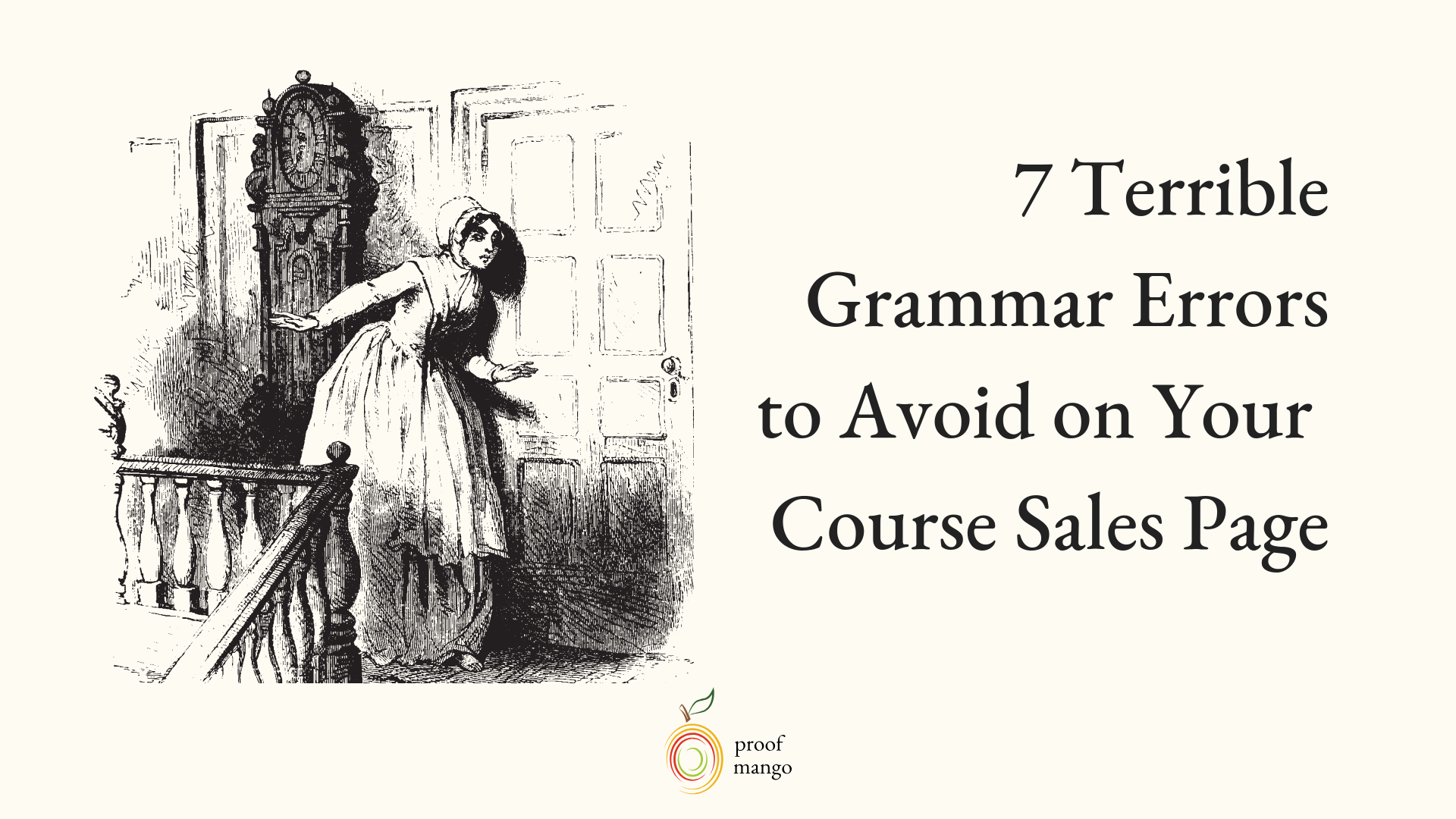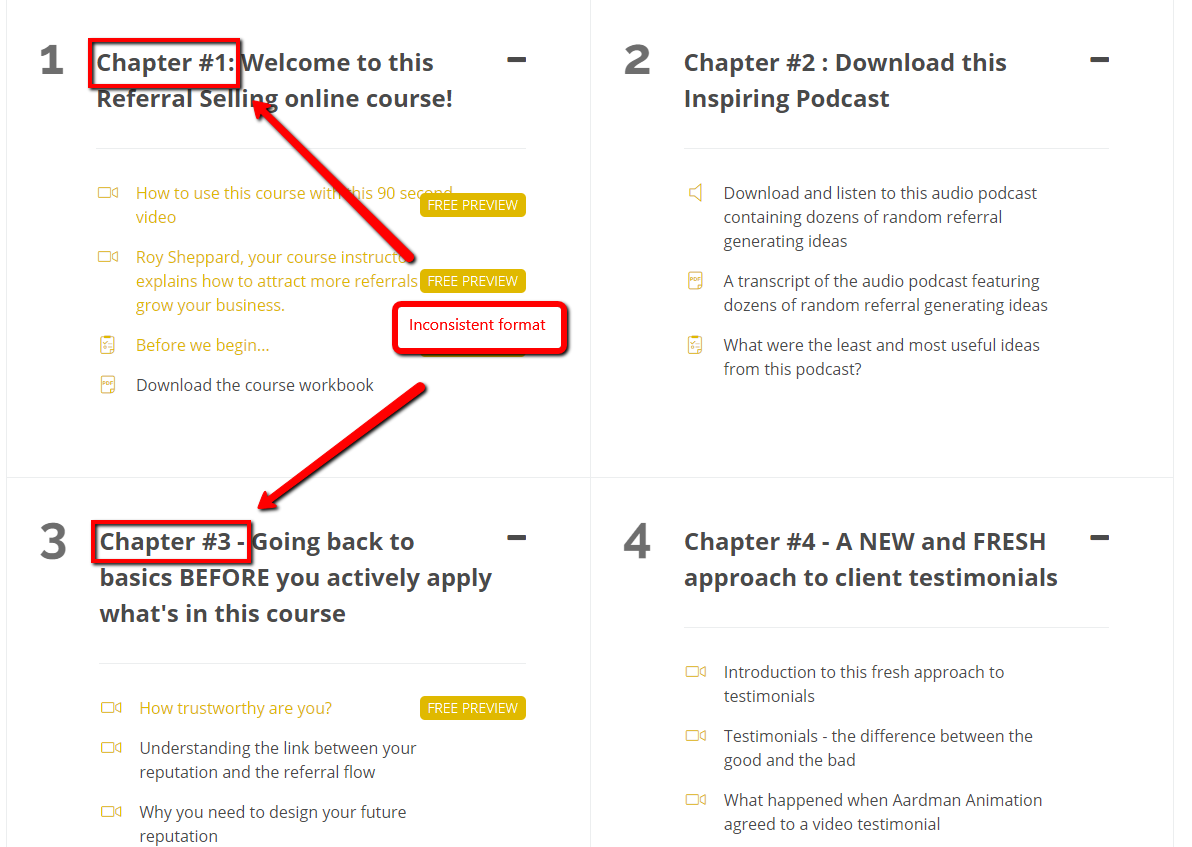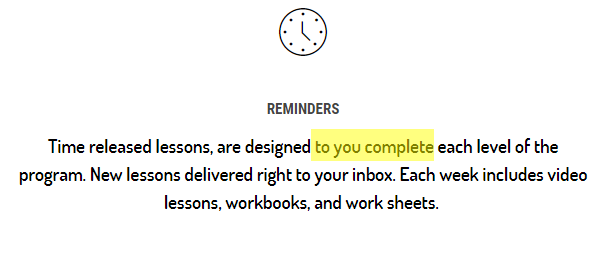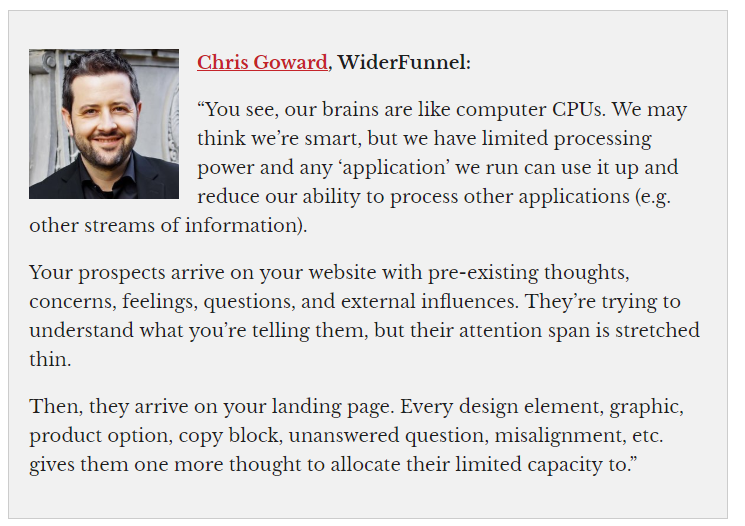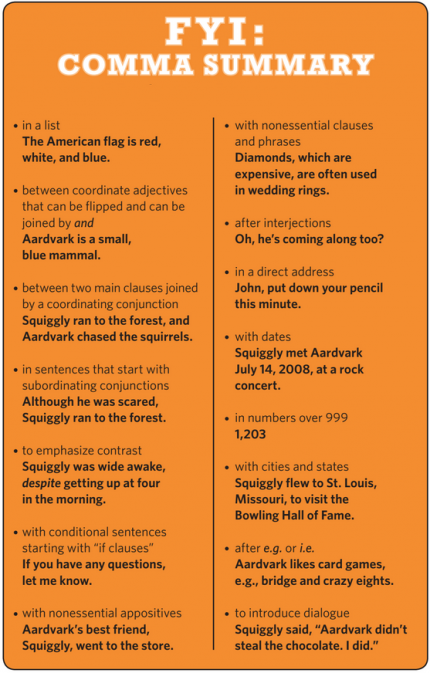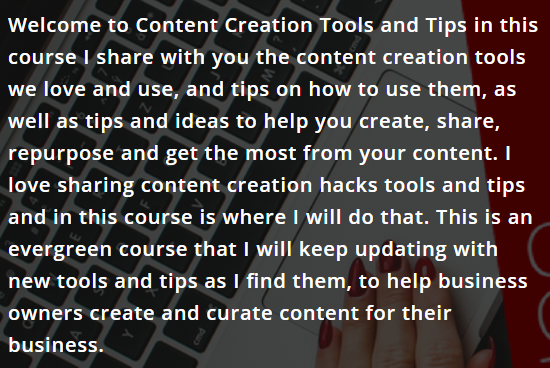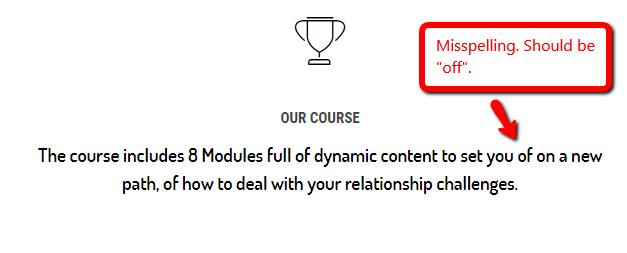“Typos are potholes on the way to a sale.”
Caitlin Pyle said this in an article on Influencive, and she couldn’t be more right — typos disrupt online course sales.
Nothing makes your course sales page look more unprofessional than a misspelled word.
But you’re only human, right?
Wrong.
When you’re selling something, you need to be superhuman. (Or at least look like it.)
Grammar and spelling errors trigger fear alarms in your students’ heads. Fear alarms give people the feeling of wanting to escape (as per Oren Klaff of Pitch Anything).
You need to look like you have all the answers and be seen as a shiny, authoritative solution to your students’ problems.
You can’t do that if you’re missing periods, commas, or even basic punctuation.
In this post, we’re diving into the most damaging spelling and grammar errors we see on course sales pages and how to avoid them at all costs.
Because good grammar is never bad for business. Clean sales copy can only help you.
Let’s take a look at some of these grammar errors and how you can avoid them.
#1 Headline Errors in Your Course Sales Page (AKA The “Unshowered” Look)
Headlines on your course sales page are high on your page’s visual hierarchy (how you arrange sales page elements to show importance).
They’re the first lines a prospective student reads when they land on your page.
And because people skim and scan sales pages, they’re sometimes the only lines prospective students read (until they get to the areas that interest them).
Spelling and grammar errors in your headlines will make your student stop. Whatever their perceptions were before they landed on your page, they’ll stop when they see your headline errors.
I like to call this the “unshowered” look because it makes headlines look just a little bit icky.
You want to make sure your headlines are always spelled correctly and structured consistently.
This eliminates those fear alarms in your potential students’ brains. You don’t want them tilting their heads, thinking:
There’s something off about the content on this page.
In fact, you don’t want them thinking anything other than: I might just have to use my credit card for this. I need it now.
Take this example of a misspelled headline in a course sales page we recently edited:
We can all understand what this copywriter meant to say, but to a potential student, this headline derails that student’s thinking in their customer journey.
Maybe they are excited to share the gift of conscious breathing, but the idea of sharing this gift has lost its luster with the misspelling above. Just a little bit.
When we talk about consistent structure in headlines, we are talking about using consistent capitalization and consistent punctuation (if we’re using it).
Take this example of inconsistent capitalization in an important sales headline:
Everything in this headline sounds great, but it reads like an untucked dress shirt. There’s just something slightly unpolished about it.
When you capitalize words in sales headlines and subheadlines, you want to capitalize all nouns, verbs, adjectives, and proper nouns.
For example: Be Your Own Digital CEO Now with Our Limited-Time Bonuses
Keep articles, conjunctions, and prepositions lowercase in your headlines and subheadlines.
As a refresher:
- Articles are words like a, an, and the
- Prepositions are words like above, through, on, off, during, etc.
Now, here’s an example of inconsistent punctuation in a headline. In this case, in module headlines:
If you’ll notice, the “Chapter #1” in the first red box has a colon after it, while the “Chapter #3” in the second red box has a hyphen.
This is the kind of stuff we catch easily because we're always on the lookout for inconsistencies. Consistency is everything to a proofreader, and it’s expected in sales copy.
If you want your course sales page to look professional and clean, take into consideration not only the grammar in your headlines but the way the headlines are structured, too.
#2 Confusing Words You Should Know (Homophones)
English is a tough language to learn. There are so many exceptions to the grammar rules, and a lot of words sound the same but mean different things (and they’re spelled differently).
These words are known as homophones. Homophones are words like to and two, four and for, and ate and eight. Every language has them, but English has a lot of them.
And unfortunately, they can wreak havoc on your course sales page. Your students are smart, and they will catch incorrect homophones (it gives some people an inordinate amount of joy when they do, believe me).
Here’s an example of a course sales page where I saw the misuse of a homophone recently:
The incorrect word here is “weather”, which is the state of the atmosphere. The word this course creator intended to use was “whether”, which means expressing a choice between two alternatives.
It’s important to understand that your students are not only smart, but they’re potential buyers. This means that they are looking at your page with extra scrutiny. This type of error will definitely cause some friction in your customer journey.
And if your words aren’t causing motivation, they’re causing friction.
If homophones are something you struggle with, there are a couple of different ways to help with this.
- List out the homophones that always give you trouble, and use the CTRL + F keyboard command to find all of these in your copy. Double check they are used correctly.
- Alternatively, you could always keep a vocabulary notebook, which FluentU recommends. List out the correct ways to use troubling homophones and review them daily to help you remember them.
As with anything, practice makes perfect. If English isn’t your first language, make it a point to practice learning it every single day.
Dutch copywriter Henneke Duistermaat recommends reading a lot in English to improve your writing and communicating in English.
On a recent episode of the Write Podcast, she also suggests looking closely at the correction marks of a good proofreader to help you understand what’s right and wrong in your copy.
#3 The Insider Mistake: Misspelling Your Own Product Name
The one mistake you never want to make in your course sales copy is misspelling your own course name.
Your course name is the thing you’re introducing and trying to sell. If you get that wrong, your potential students will be turned off quickly.
Here’s a quick example:
In the example above, a blue pint sounds pretty tasty, but I don’t think it’s what the course author meant.
Always use CTRL + F to find all uses of your course name in your sales copy. Make sure the capitalization is consistent, and that all words are spelled correctly.
Don’t forget to scan any images mentioning the course as well, since using CTRL + F won’t find those when it scans the page.
Spelling your course name correctly is a way of taking pride in your product. When important names and features of your course are spelled right, it just makes your end product look a whole lot tastier.
Think of good spelling and grammar as a way of giving your students a preview of how well your course is going to look when they buy it. Let them know right off the bat what kind of content to expect from you (the best kind).
#4 The Invisible Word: Forgetting Words Due to Your Light Speed Brain
You know those sentences with missing words that still make sense when you read them because you're reading them at light speed?
These are VERY common on course sales pages. But unfortunately, your potential students will catch these missing words because they’re reading specific parts of your sales pages more closely than you are. Especially if they’re considering your offer.
Here’s an example of an invisible word in an important section on what a module includes:
The invisible word here seems to be “help”. The sentence should read, “Time-released lessons are designed to help you complete each level of the program.”
But without the word “help”, it feels like important information is missing. It’s a bit like the pothole Caitlin Pyle describes at the beginning of this post.
It’s like your student is walking along and twists her ankle on a little pothole she didn’t see coming. She stops, re-reads, and then tries to process the sentence to determine what it needs to make sense.
All of this is too much brain power wasted on the wrong thing in your sales page.
Take a look at what Chris Goward of Wider Funnel had to say on Conversion XL’s blog on how important it is to keep your potential buyers’ brain processing to a minimum.
And the unfortunate part about these invisible words is that grammar checkers rarely catch them. In fact, when you put that example sentence above in Grammarly, it says there are no issues.
Which is a bit of an issue.
Catching invisible words takes an attentive eye. You have to read your sales copy out loud slowly in order to catch it. Otherwise, your light speed brain blazes right through it and doesn’t see an issue.
But keep in mind that your potential course buyers are reading slowly, and they’re paying attention. It’s important that you do, too.
Here’s another quick example:
This course author is listing out the pain points her potential course buyer is probably feeling. The problem is, one of the pain points doesn’t make sense. It should say, “You WISH you had an expert…” instead of “You WISH you an expert”.
At first read, part of me saw this as, “You WISH you were an expert”. But as I read on, I realized it should be “had”, and I had to re-read the entire thing to be sure.
Don’t make your potential students do double takes. Give them a premium experience of your brand by making sure every spelling and punctuation error has been fixed.
#5 The Comma Offender
Commas are terrible, and I’ll be the first to admit it. Sometimes, you never know where to put them.
Some people use them too often, other people don’t use them enough.
Here’s an example of using a comma too often on a course sales page:
There’s no need to add commas in this sentence at all — it’s fine as, “Reach and grow your online audience (so you have people to sell your course to!)”.
Commas mean pausing, and you don’t want your students pausing unnecessarily. Especially when your writing should be simple and direct.
As a refresher, here is a graphic to help you remember when to use commas:
Via Grammar Girl
If you want to get into the nitty-gritty with this in your sales page, use CTRL + F to find all of your commas and cross-check them with this chart to be sure you’re using them correctly.
#6 The Never-ending Sentence (Because I Just Need to Get This Out)
There are some scary long sentences out there. I mean, have you seen the preamble?
I’m guessing our Founding Fathers weren’t into mincing words.
You don’t want run-on sentences in your course sales page. As an editor, they make my brain hurt. And I know you don’t want that for your potential students.
In case you’re not familiar, a run-on sentence is when two or more independent clauses aren’t separated by a colon, a semicolon, or a period.
In basic English, it means they're two complete sentences within a sentence without anything separating them.
Here is a quick example from Grammar Revolution (one of my favorite grammar sites).
Let’s take a look at a run-on sentence example on an actual course sales page. Tell me if your brain can process this:
That first sentence is tough to get through. I know it’s easy to write long sentences because you just want to get everything out.
But they’ll only confuse your potential students and make them want to quit reading.
We could easily break the example sentence above into three sentences. Here they are below:
“Welcome to Content Creation Tools and Tips!
In this course, I share with you the content creation tools we love and use.
I share tips on how to use them, as well as tips and ideas to help you create, share, repurpose, and get the most from your content.”
While we could probably sever more words in the final sentence, this reads much easier.
If there are sentences in your sales copy that could be tightened up, just try adding a period between the independent clauses in your sentences. (Note: Independent clauses can stand on their own because they are a complete idea. For example, these are independent clauses: “Sign up now.” and “This tool works.”)
Run-on sentences tend to have multiple commas or 20+ words. They should be relatively easy to spot in your copy. But if you’re still having trouble finding them, add them to the Hemingway App editor. It’ll highlight words that are too wordy and hard to read.
#7 The Correctly Spelled Word That’s Used Incorrectly (and Rarely Caught)
Sometimes online grammar checkers say there's no issue with copy that is still incorrect.
Take this example:
On the surface, the text above looks correct. But reading it closely, we can see that it’s not. This is why it’s so important to proofread your work by reading it aloud slowly.
The writer, in this case, used “of” when she should have used “off”. But it's hard to catch this when “of” is technically spelled correctly.
Here’s another one:
There’s nothing misspelled in the text above, but it still doesn’t make sense.
There are a couple of ways we can correct this. It’s always best to ask the writer what they meant instead of guessing, but I’d bet they meant one of two sentences below:
“Is your relationship status: Single, Married, or It’s Complicated? Or are you just confused?”
OR
“If your relationship status is Single, Married, It’s Complicated, or you’re just confused, our unique holistic approach…”
Either way, it reads incorrectly as is, and it’ll confuse prospective students.
And confusion is never a precursor to buying.
The solution to this is just to make sure you have a second pair of eyes on your copy. Have someone else look at it or get some distance from it, and then re-read it again slowly before publishing it.
Often, we’re so married to our work that we can’t see the blatant errors within it. It helps to have a non-biased reader come in and double check everything.
In the end, you’ll look way more authoritative and have much more sway with your potential students.
And remember, good spelling and grammar is never bad for business.
It can only help. So double check, and then check again.
Summary
One of the best ways to remove friction in your sales copy is to make sure it’s free of error. Your potential students want to know how you can help them. Don’t hurt them (and your chances of selling) by misspelling words or using bad punctuation.
Here’s a quick summary of what we covered today:
- Headlines are the most important places on your course sales page to have clean copy. Prospective students won’t dig deeper into your sales copy unless they find something interesting in your headlines — make sure they’re spelled correctly and structured consistently.
- Homophones are words that sound the same but are spelled differently. Use CTRL + F in your copy to find homophones you tend to misspell and study the correct ways to spell them on a daily basis.
- Misspelling your course name is a surefire way to confuse your student (and lose a sale). Use CTRL + F to find every mention of your course name in your sales copy and double check it’s spelled correctly every time.
- Invisible words are words in your sales copy that you forget to add, because of your light speed brain. This means your thoughts are moving at light speed when you’re writing, and you forget to include important words. Read your content slowly aloud to make sure every word you meant to say is included in your course sales page.
- Double check every comma in your sales copy. Use the comma graphic in this post to make sure you’re using them correctly.
- Run-on sentences are sentences within a sentence, and they’ll take away from your sales message. Check every long sentence in your sales copy to see if it can be broken out into two or three sentences instead.
- Words can still be wrong, even if they’re spelled correctly. For example, using “of” when you meant to use “off”. Read your copy aloud slowly, and don’t rely on online grammar checkers by themselves.
Are you making some of these errors in your course sales page copy? What words or grammar rules do you struggle with most? Let me know in the comments!

